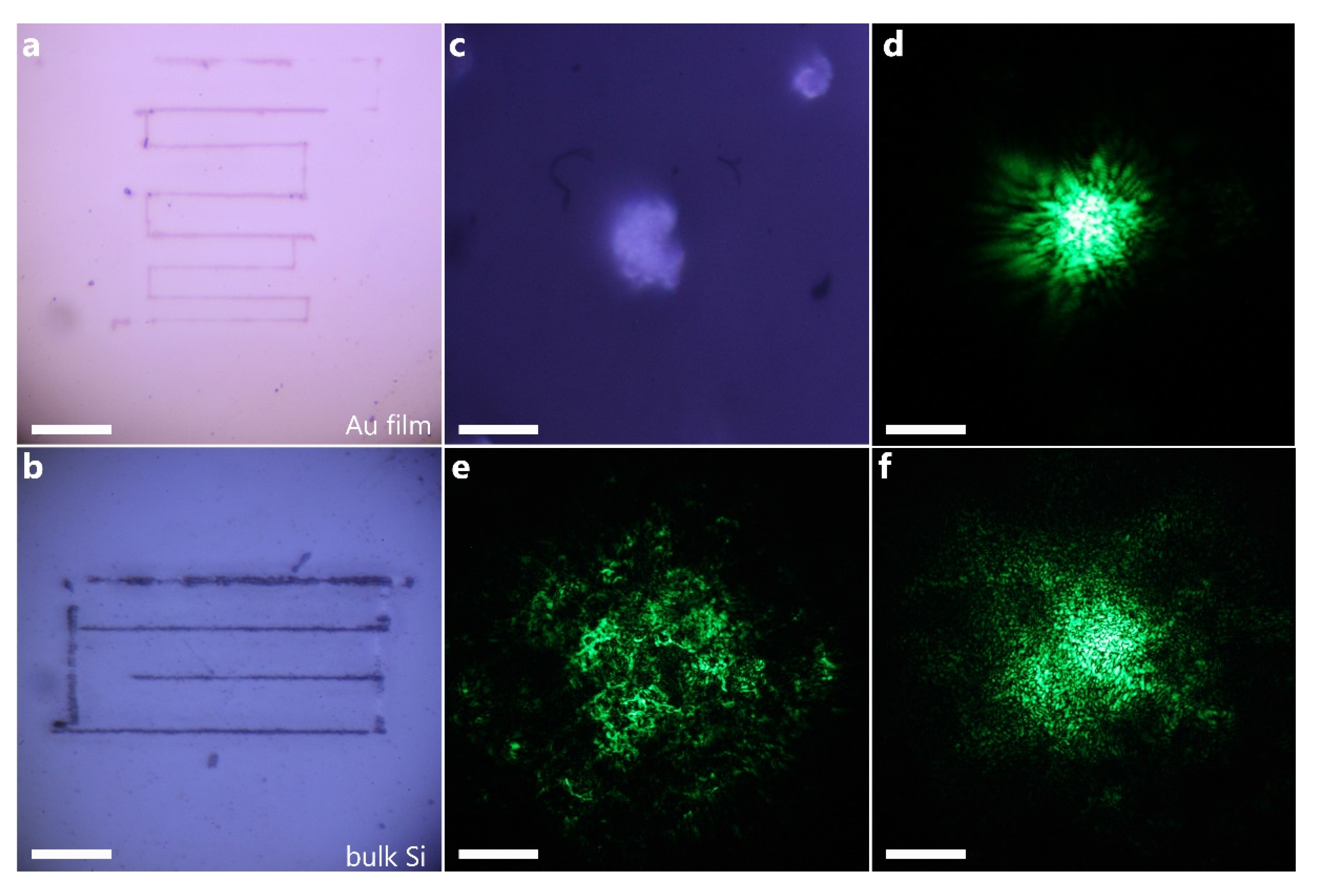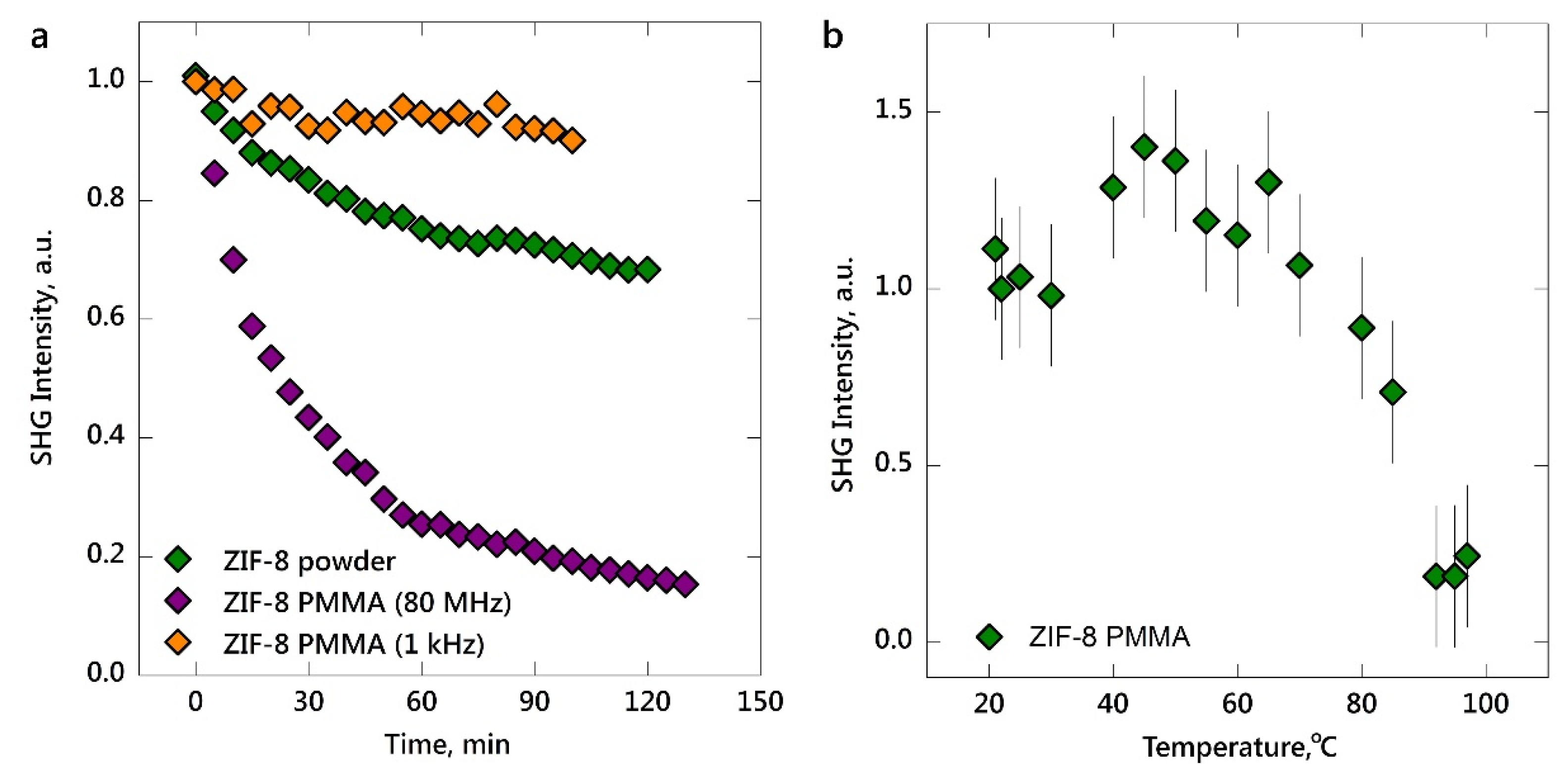Polymer Matrix Incorporated with ZIF-8 for Application in Nonlinear Optics
Abstract
1. Introduction
2. Materials and Methods
3. Results and Discussion
4. Conclusions
Author Contributions
Funding
Conflicts of Interest
References
- Furukawa, H.; Müller, U.; Yaghi, O.M. Heterogeneity within order in metal–organic frameworks. Angew. Chem. Int. Ed. 2015, 54, 3417–3430. [Google Scholar] [CrossRef] [PubMed]
- Lu, K.; Aung, T.; Guo, N.; Weichselbaum, R.; Lin, W. Nanoscale metal-organic frameworks for therapeutic, imaging, and sensing applications. Adv. Mater. 2018, 30, 1707634. [Google Scholar] [CrossRef] [PubMed]
- Mezenov, Y.A.; Krasilin, A.A.; Dzyub, V.P.; Nominé, A.; Milichko, V.A. Metal-organic frameworks in modern physics: Highlights and perspectives. Adv. Sci. 2019, 6, 1900506. [Google Scholar] [CrossRef]
- Widmer, R.N.; Lampronti, G.I.; Chibani, S.; Wilson, C.W.; Anzellini, S.; Farsang, S.; Kleppe, A.K.; Casati, N.P.M.; MacLeod, S.G.; Redfern, S.A.T.; et al. Rich polymorphism of a metal–organic framework in pressure–Temperature space. J. Am. Chem. Soc. 2019, 141, 9330–9337. [Google Scholar] [CrossRef] [PubMed]
- Mingabudinova, L.R.; Vinogradov, V.V.; Milichko, V.A.; Hey-Hawkins, E.; Vinogradov, A.V. Metal–organic frameworks as competitive materials for non-linear optics. Chem. Soc. Rev. 2016, 45, 5408–5431. [Google Scholar] [CrossRef] [PubMed]
- Banerjee, D.; Kim, S.J.; Parise, J.B. Lithium based metal−organic framework with exceptional stability. Cryst. Growth Des. 2009, 9, 2500–2503. [Google Scholar] [CrossRef]
- Wang, C.; Liu, X.; Keser, D.N.; Chen, J.P.; Li, K. Applications of water stable metal–organic frameworks. Chem. Soc. Rev. 2016, 45, 5107–5134. [Google Scholar] [CrossRef]
- Lv, Y.; Xiong, Z.; Yao, Z.; Yang, Y.; Xiang, S.; Zhang, Z.; Zhao, Y.S. Steric-hindrance-controlled laser switch based on pure metal–organic framework microcrystals. J. Am. Chem. Soc. 2019, 141, 19959–19963. [Google Scholar] [CrossRef]
- Wang, C.; Zhang, T.; Lin, W. Rational synthesis of noncentrosymmetric metal-organic frameworks for second-order nonlinear optics. Chem. Rev. 2012, 112, 1084–1104. [Google Scholar] [CrossRef]
- Milichko, V.A.; Makarov, S.V.; Yulin, A.V.; Vinogradov, A.V.; Krasilin, A.A.; Ushakova, E.; Dzyuba, V.P.; Hey-Hawkins, E.; Pidko, E.A.; Belov, P.A. van der Waals metal-organic framework as an excitonic material for advanced photonics. Adv. Mater. 2017, 29, 1606034. [Google Scholar] [CrossRef]
- Kirchon, A.; Feng, L.; Drake, H.F.; Joseph, E.A.; Zhou, H.C. From fundamentals to applications: A toolbox for robust and multifunctional MOF materials. Chem. Soc. Rev. 2018, 47, 8611–8638. [Google Scholar] [CrossRef]
- Stassen, I.; Styles, M.; Grenci, G.; Gorp, H.V.; Vanderlinden, W.; Feyter, S.D.; Falcaro, P.; Vos, D.D.; Vereecken, P.; Ameloot, R. Chemical vapour deposition of zeolitic imidazolate framework thin films. Nat. Mater. 2016, 15, 304–310. [Google Scholar] [CrossRef] [PubMed]
- Seoane, B.; Coronas, J.; Gascon, I.; Benavides, M.E.; Karvan, O.; Caro, J.; Kapteijn, F.; Gascon, J. Metal–organic framework based mixed matrix membranes: A solution for highly efficient CO2 capture? Chem. Soc. Rev. 2015, 44, 2421–2454. [Google Scholar] [CrossRef] [PubMed]
- Denny Jr., M.S.; Cohen, S.M. In situ modification of metal–organic frameworks in mixed-matrix membranes. Angew. Chem. Int. Ed. 2015, 54, 9029–9032. [Google Scholar] [CrossRef] [PubMed]
- Çalhan, A.; Deniz, S.; Romero, J.; Hasanoğlu, A. Development of metal organic framework filled PDMS/PI composite membranes for biobutanol recovery. Korean J. Chem. Eng. 2019, 36, 1489–1498. [Google Scholar] [CrossRef]
- Moscoso, F.G.; Almeida, J.; Sousaraei, A.; Lopes-Costa, T.; Silva, A.M.G.; Cabanillas-Gonzalez, J.; Cunha-Silva, L.; Pedrosa, J.M. Luminescent MOF crystals embedded into PMMA/PDMS transparent films as effective NO2 gas sensors. Mol. Syst. Des. Eng. 2020. [Google Scholar] [CrossRef]
- Katayama, Y.; Kalaj, M.; Barcus, K.S.; Cohen, S.M. Self-assembly of metal−organic framework (MOF) nanoparticle monolayers and free-standing multilayers. J. Am. Chem. Soc. 2019, 141, 20000–20003. [Google Scholar] [CrossRef]
- Hossein, M.; Akbar, S.; Seyyed, A.M. Improving mixed-matrix membrane performance 1 via PMMA grafting 2 from functionalized NH2-UiO-66. J. Mater. Chem. A 2018, 6, 2775–2791. [Google Scholar]
- Zhang, F.; Yao, H.; Zhao, Y.; Li, X.; Zhang, G. Mixed matrix membranes incorporated with Ln-MOF for selective and sensitive detection of nitrofuran antibiotics based on inner filter effect. Talanta 2017, 174, 660–666. [Google Scholar] [CrossRef]
- Park, K.S.; Ni, Z.; Côté, A.P.; Choi, J.Y.; Huang, R.; Uribe-Romo, F.J.; Chae, H.K.; O’Keeffe, M.; Yaghi, O.M. Exceptional chemical and thermal stability of zeolitic imidazolate frameworks. Proc. Nat. Acad. Sci. USA 2006, 103, 10186–10191. [Google Scholar] [CrossRef]
- Cleuvenbergen, S.V.; Stassen, I.; Gobechiya, E.; Zhang, Y.; Markey, K.; De Vos, D.E.; Kirschhock, C.; Champagne, B.; Verbiest, T.; van der Veen, M.A. ZIF-8 as nonlinear optical material: Influence of structure and synthesis. Chem. Mater. 2016, 28, 3203–3209. [Google Scholar] [CrossRef]
- Yin, H.; Kim, H.; Choi, J.; Yip, A.C.K. Thermal stability of ZIF-8 under oxidative and inert environments: A practical perspectives on using ZIF-8 as a catalytic support. Chem. Engineer. J. 2015, 278, 293–300. [Google Scholar] [CrossRef]
- Wu, C.; Xie, D.; Mei, Y.; Xiu, Z.; Poduska, K.M.; Li, D.; Xu, B.; Sun, D. Unveiling thermolysis natures of ZIF-8 and ZIF-67 employing in situ structural characterizations. Phys. Chem. Chem. Phys. 2019, 21, 17571–17577. [Google Scholar] [CrossRef] [PubMed]
- Ferriol, M.; Gentilhomme, A.; Cochez, M.; Oget, N.; Mieloszynski, J.L. Thermal degredation of poly(methyl methacrylate) (PMMA) modeling of DTG and TG curves. Polymer Degrad. Stab. 2003, 79, 271–281. [Google Scholar] [CrossRef]
- Makarov, S.V.; Milichko, V.A.; Mukhin, I.S.; Shishkin, I.I.; Zuev, D.A.; Mozharov, A.M.; Krasnok, A.E.; Belov, P.A. Controllable femtosecond laser-induced dewetting for plasmonic applications. Laser. Photon. Rev. 2016, 10, 91–99. [Google Scholar] [CrossRef]
- Thorlabs. Available online: https://www.thorlabs.com/newgrouppage9.cfm?objectgroup_id=296 (accessed on 9 April 2020).
- Srinivasan, R.; Braren, B. Ultraviolet laser ablation of organic polymers. Chem. Rev. 1989, 89, 1303–1316. [Google Scholar] [CrossRef]
- Bennett, H.E.; Chase, L.L.; Guenther, A.H.; Newman, B.E. Laser Induced Damage in Optical Materials, 1989: Proceedings of the Boulder Damage Symposium, November 1–3, 1989; Society of Photo-Optical: Bellingham, WA, USA, 1990. [Google Scholar]
- Canossa, S.; Ji, Z.; Wuttke, S. Circumventing wear and tear of adaptive porous materials. Adv. Funct. Mater. 2020, 1908547. [Google Scholar] [CrossRef]



© 2020 by the authors. Licensee MDPI, Basel, Switzerland. This article is an open access article distributed under the terms and conditions of the Creative Commons Attribution (CC BY) license (http://creativecommons.org/licenses/by/4.0/).
Share and Cite
Mezenov, Y.A.; Kulachenkov, N.K.; Yankin, A.N.; Rzhevskiy, S.S.; Alekseevskiy, P.V.; Gilemkhanova, V.D.; Bachinin, S.V.; Dyachuk, V.; Milichko, V.A. Polymer Matrix Incorporated with ZIF-8 for Application in Nonlinear Optics. Nanomaterials 2020, 10, 1036. https://doi.org/10.3390/nano10061036
Mezenov YA, Kulachenkov NK, Yankin AN, Rzhevskiy SS, Alekseevskiy PV, Gilemkhanova VD, Bachinin SV, Dyachuk V, Milichko VA. Polymer Matrix Incorporated with ZIF-8 for Application in Nonlinear Optics. Nanomaterials. 2020; 10(6):1036. https://doi.org/10.3390/nano10061036
Chicago/Turabian StyleMezenov, Yuri A., Nikita K. Kulachenkov, Andrei N. Yankin, Sergey S. Rzhevskiy, Pavel V. Alekseevskiy, Venera D. Gilemkhanova, Semyon V. Bachinin, Vyacheslav Dyachuk, and Valentin A. Milichko. 2020. "Polymer Matrix Incorporated with ZIF-8 for Application in Nonlinear Optics" Nanomaterials 10, no. 6: 1036. https://doi.org/10.3390/nano10061036
APA StyleMezenov, Y. A., Kulachenkov, N. K., Yankin, A. N., Rzhevskiy, S. S., Alekseevskiy, P. V., Gilemkhanova, V. D., Bachinin, S. V., Dyachuk, V., & Milichko, V. A. (2020). Polymer Matrix Incorporated with ZIF-8 for Application in Nonlinear Optics. Nanomaterials, 10(6), 1036. https://doi.org/10.3390/nano10061036




